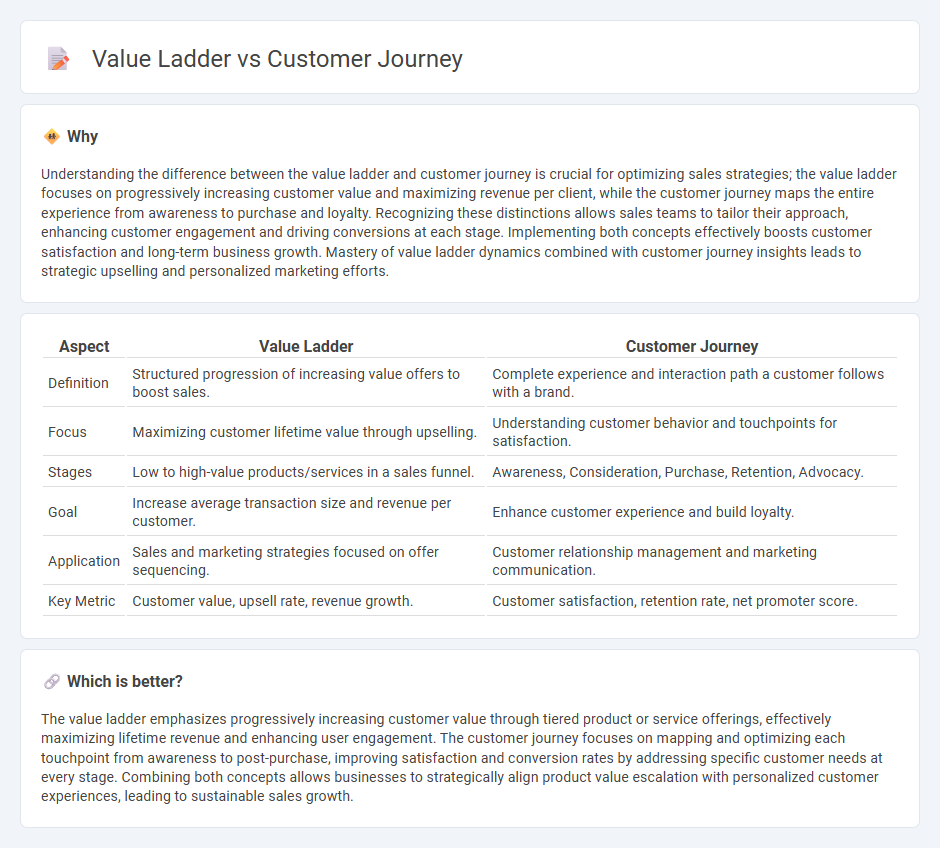
The value ladder represents a strategic approach to increasing customer lifetime value by offering progressively higher-value products or services, while the customer journey outlines the stages a buyer goes through from awareness to purchase. Understanding how the value ladder aligns with each phase of the customer journey can enhance sales effectiveness and improve customer retention. Explore how integrating these concepts can optimize your sales strategy and boost revenue growth.
Why it is important
Understanding the difference between the value ladder and customer journey is crucial for optimizing sales strategies; the value ladder focuses on progressively increasing customer value and maximizing revenue per client, while the customer journey maps the entire experience from awareness to purchase and loyalty. Recognizing these distinctions allows sales teams to tailor their approach, enhancing customer engagement and driving conversions at each stage. Implementing both concepts effectively boosts customer satisfaction and long-term business growth. Mastery of value ladder dynamics combined with customer journey insights leads to strategic upselling and personalized marketing efforts.
Comparison Table
| Aspect | Value Ladder | Customer Journey |
|---|---|---|
| Definition | Structured progression of increasing value offers to boost sales. | Complete experience and interaction path a customer follows with a brand. |
| Focus | Maximizing customer lifetime value through upselling. | Understanding customer behavior and touchpoints for satisfaction. |
| Stages | Low to high-value products/services in a sales funnel. | Awareness, Consideration, Purchase, Retention, Advocacy. |
| Goal | Increase average transaction size and revenue per customer. | Enhance customer experience and build loyalty. |
| Application | Sales and marketing strategies focused on offer sequencing. | Customer relationship management and marketing communication. |
| Key Metric | Customer value, upsell rate, revenue growth. | Customer satisfaction, retention rate, net promoter score. |
Which is better?
The value ladder emphasizes progressively increasing customer value through tiered product or service offerings, effectively maximizing lifetime revenue and enhancing user engagement. The customer journey focuses on mapping and optimizing each touchpoint from awareness to post-purchase, improving satisfaction and conversion rates by addressing specific customer needs at every stage. Combining both concepts allows businesses to strategically align product value escalation with personalized customer experiences, leading to sustainable sales growth.
Connection
The value ladder enhances the customer journey by strategically guiding buyers through increasing levels of product or service value, boosting engagement and loyalty at each stage. Mapping customer touchpoints along the journey aligns with the value ladder's tiers, ensuring personalized offers and experiences that meet evolving needs. This connection maximizes customer lifetime value by transforming initial interactions into long-term relationships through progressive value delivery.
Key Terms
**Customer Journey:**
The Customer Journey maps the stages a user experiences from awareness to post-purchase, emphasizing touchpoints and emotional engagement to optimize conversions and retention. It highlights interactions across channels such as social media, websites, and customer support, ensuring a seamless brand experience that drives loyalty. Explore how mastering the Customer Journey can elevate your marketing strategy and boost customer satisfaction.
Awareness
The customer journey focuses on the awareness stage as the initial step where potential customers recognize a need or problem, while the value ladder emphasizes progressively delivering increasing value to move customers from basic awareness to higher engagement levels. Both frameworks aim to guide prospects through a series of touchpoints, but the customer journey specifically maps emotional and decision-making phases, whereas the value ladder concentrates on incremental value offerings. Explore the detailed strategies behind awareness in customer journey and value ladder frameworks to enhance marketing effectiveness.
Consideration
The Consideration stage in the customer journey involves evaluating options, where customers compare features, benefits, and pricing to make informed decisions. The Value Ladder emphasizes progressively increasing the offer's value to guide customers from basic to premium products or services during this evaluation phase. Explore how aligning these strategies can enhance customer engagement and conversion rates.
Source and External Links
Customer journey - definition and use cases - The customer journey describes the stages a customer goes through before, during, and after interacting with a product or service, including awareness, consideration, decision, adoption, and advocacy, each contributing to the overall customer experience and brand loyalty.
Customer Journey Map: Definition & Process | IxDF - Customer journey maps visually represent the customer's experience, highlighting the five main stages: awareness, consideration, purchase, retention, and advocacy, and involve stakeholders to identify customer needs and journey gaps.
The customer journey -- definition, stages, and benefits - The customer journey is a series of steps from brand awareness to purchase and loyalty, used by businesses to optimize customer experience and build long-term relationships beyond just the buyer's journey.
 dowidth.com
dowidth.com